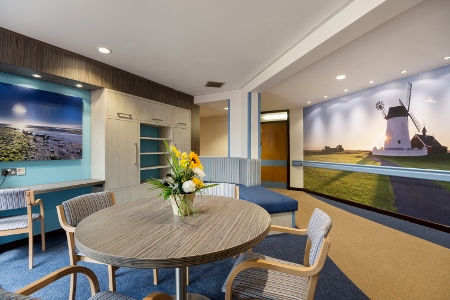A heart-wrenching phone call from the relative of a woman who had passed away at Trinity Hospice in Blackpool sparked a redevelopment project that is helping to set a precedent for palliative care across the UK.
In 2012, Julie Huttley, clinical director of the hospice, took a call from the niece of a lady who had died at the unit three years previously. Only after that time did she feel able to talk about her experience.
Trinity prides itself on excellent, compassionate care at end of life and now has a future-proof environment ready to face the challenges of demographic change, medical advance and increased expectation around individual end of life care
While she praised the care provided by staff at the unit, she said that as her relative was dying her breathing was very noisy. Her aunt was not distressed, but she felt embarrassed for the other patients in the room and apologised. She advised that if the hospice ever had the chance to create more single rooms to increase privacy and dignity, it should.
This conversation was the catalyst for a complete overhaul of the facility, a scheme that was shortlisted by judges as this year’s Building Better Healthcare Awards.
Working with experts from The King’s Fund, the hospice management team and designers, Gilling Dod Architects, held workshops with patients, their families and members of staff to plan the refurbishment of the adult inpatient unit and improvements to Brian House Children’s Hospice.
The work was carried out as Trinity approached its 30th anniversary.
Among the improvements are architectural alterations aimed at enhancing and maximising the internal layout, resulting in the provision of all-important additional single bedrooms, accessible en-suite shower rooms, and discreet off-ward seating areas for private discussions.
Privacy, dignity and patient choice were at the heart of the brief for the revamp, with patients now able to choose between single or double-occupancy rooms, with relatives also able to stay overnight on sofabeds within their loved ones’ rooms, or close by in newly-refurbished overnight rooms.
Also key to the project was to enhance wayfinding, making the unit easier to navigate. This was achieved through the use of coloured zoning, with red, blue and turquoise areas further emphasised with artwork installations, many commissioned specifically for the scheme.
New signage, colour coded to match each zone, is dementia friendly and toilet and bathroom doors have been painted yellow so they can be easily identified. Accessibility is further enhanced by the introduction of strongly-coloured handrails, and the replanning of the internal layout has allowed the assisted bathroom to be greatly increased in size. A new access control system ensures patient safety.
All finishes throughout the hospice have been selected to create a warm, reassuring and homely environment, with wallpaper and carpeting throughout, together with non-clinical upholsteries and curtains. All meet stringent infection control policies and are easy to clean.
“These innovations and advances in materials set a precedent for future schemes, and their durability and ease of maintenance will ensure that the finishes achieve a long lifespan,” said Sarah Delucia-Crook, business development manager at Gilling Dod Architects.
Sustainability was also a key consideration and from the outset all elements that could be retained and refurbished, such as doors, were identified. New energy-efficient lighting was installed throughout as well as replacement windows.
A patient said of the redevelopment: “I am amazed at the transformation and lightness of the corridors. The single room has given me increased privacy and dignity particularly because of the en-suite bathroom. I am able to sit in a chair in the window overlooking the gardens. This would be wonderful, even if it was raining, not as the sun is shining today. I already feel much better than I have for days.”
These innovations and advances in materials set a precedent for future schemes, and their durability and ease of maintenance will ensure that the finishes achieve a long lifespan
At the adjoining Brian House Children’s Hospice improvements were also made. The original kitchen has been replanned and replaced with candy-coloured units and a digitally-printed splashback and bespoke vinyl flooring of marshallows adds a sense of fun to the space, as does a mini play kitchen. The lounge now has an underwater sealife wall and bedrooms have been rethemed.
The work was completed in two phases over seven months as both adult and children’s units had to remain open and operational throughout.
Huttley said: “Trinity prides itself on excellent, compassionate care at end of life and now has a futureproof environment ready to face the challenges of demographic change, medical advance and increased expectation around individual end of life care.”






